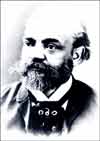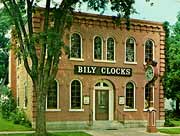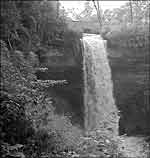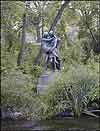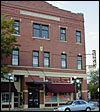|
Maestro in the Midwest The Dvorak Timeline - Following in Dvorák's Footsteps
ANTONÍN DVORÁK
STARTED LIFE as the son of a peasant in the provinces of the Austro-Hungarian
Empire, and ended it as one of the most famous musicians in the world, whose pieces
were eagerly received by audiences in the capitals of Europe and America.
True, the popularity of some of those works may have waned a bit over the years; perhaps the Te Deum and the Moravian Duets don't loom as large as they once did. On the other hand, no cellist will neglect Dvorák's b-minor concerto; and there can't be too many classical record collections without a "New World" Symphony, or a selection of his Slavonic Dances. And there can't be too many American music lovers, especially in the Midwest, who haven't thought about retracing some of the steps of the remarkable journey that Dvorák took to the United States in the 1890s. While in America, he not only presided over a New York conservatory, and gave a new impetus to American composers, but also came to live in a tiny town in Iowa, visited the young cities of Minneapolis and St. Paul, and wrote some of his most popular works. Here, to celebrate the composer's birthday on September 8, is a scrapbook of Dvorakiana: a look at some of the Midwest's Dvorák sites; a timeline of Dvorák's life, and samples of his music. A Dvorák Timeline
1874 Dvorák applies for an Austrian government grant for artists. One of the judges is Johannes Brahms; on his recommendation, Brahms's publisher issues Dvorák's Slavonic Dances, with resounding success. In the next two decades, Dvorak will produce symphonies, choral works, concertos With these works, Dvorak consolidates his international reputation as one of the leading composers on the scene. It is a time of rising pride among the Slav peoples, and like the Slavonic Dances, many of Dvorák's works reflect the spirit of Slavic folk music, and Dvorák's pride in his Czech heritage. 1891 A wealthy New York woman, Jeannette Thurber, invites Dvorák to come to New York to head her new conservatory. After some hesitation, Dvorák accepts. 1892 While in America, Dvorák takes an interest in the music of African-Americans and American Indians. He urges American composers to compose in the spirit of the music they hear around them: "I am now satisfied that the future music of this country must be founded upon what are called the negro melodies. This must be the real foundation of any serious and original school of composition to be developed in the United States." None of Dvorák's students becomes a notable composer, though they go on to teach and influence a generation of American composers: Gershwin, Copland, Ellington.
1893 Dvorák spends the summer in Spillville, Iowa, a small Czech settlement in northeastern Iowa. Within five days of his arrival, he composes his "American" String Quartet.
Besides composing and enjoying the company of his fellow Czechs, he also attends church frequently, and plays organ during the mass.
1893 World premiere of Dvorák's Symphony No. 9, subtitled "From the New World" in Carnegie Hall. During his years in America, Dvorák will write some of his most popular pieces: not only the "New World" Symphony, but the Cello Concerto, the "American" String Quartet, and a beloved miniature, the Humoresque in G-Flat. Whether Dvorák himself adopted an "American" style in these works is one is one of the great debates of Dvorák scholarship. 1895 Dvorák suffers from homesickness and has business disagreements with Mrs. Thurber He decides to return to Europe permanently. In the last part of his career he devotes himself mainly to opera, producing his most popular opera, Rusalka, in 1901.
1904 Dvorák's health now begins to decline. Always a train enthusiast, he goes one morning to look at the locomotives at the Prague railway station and comes down with a chill - the beginning of his final illness. Dvorák dies in May of 1904 and is buried in Prague.
Following in Dvorák's Footsteps
|
|||||||||||||||||||||
